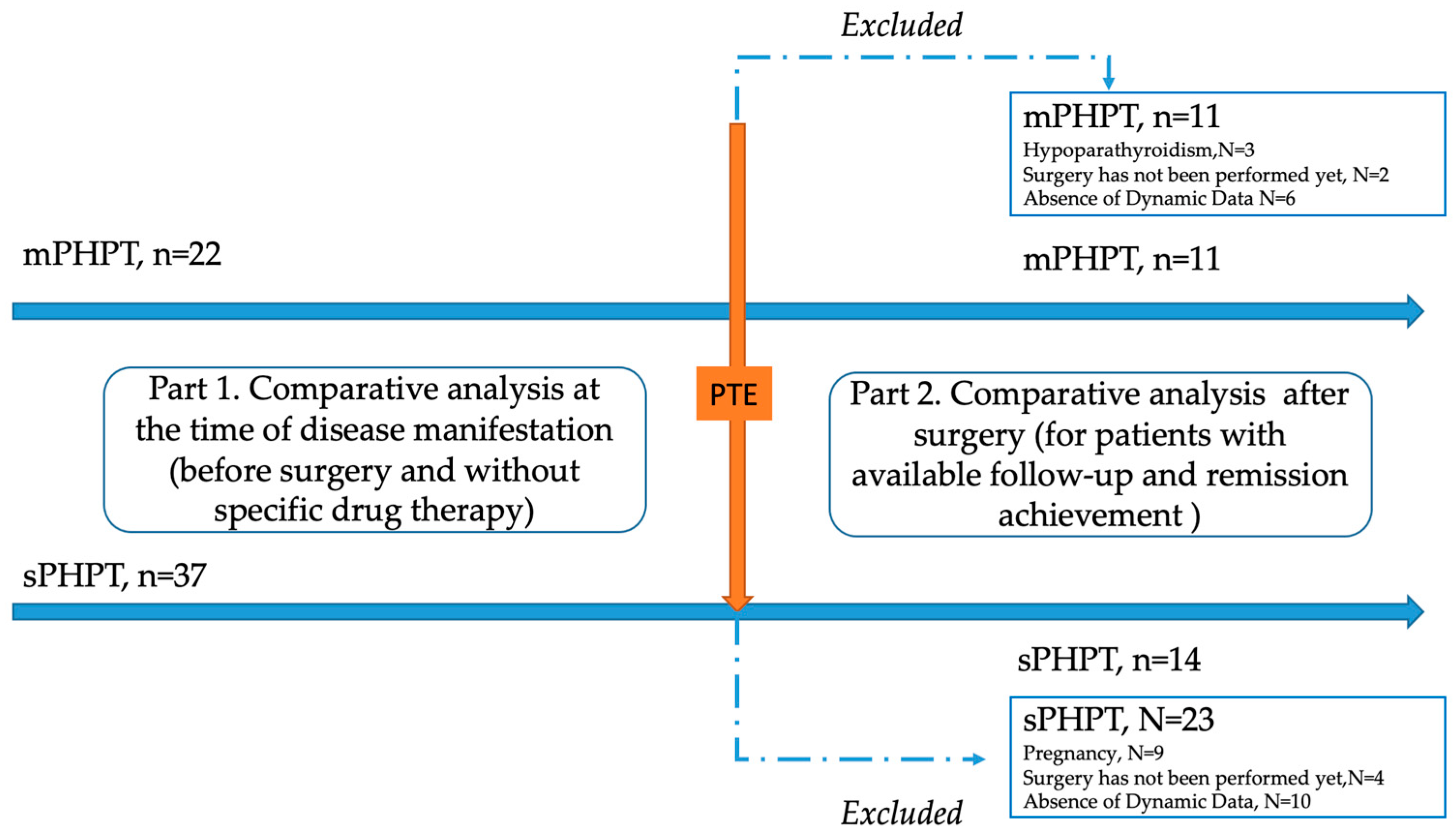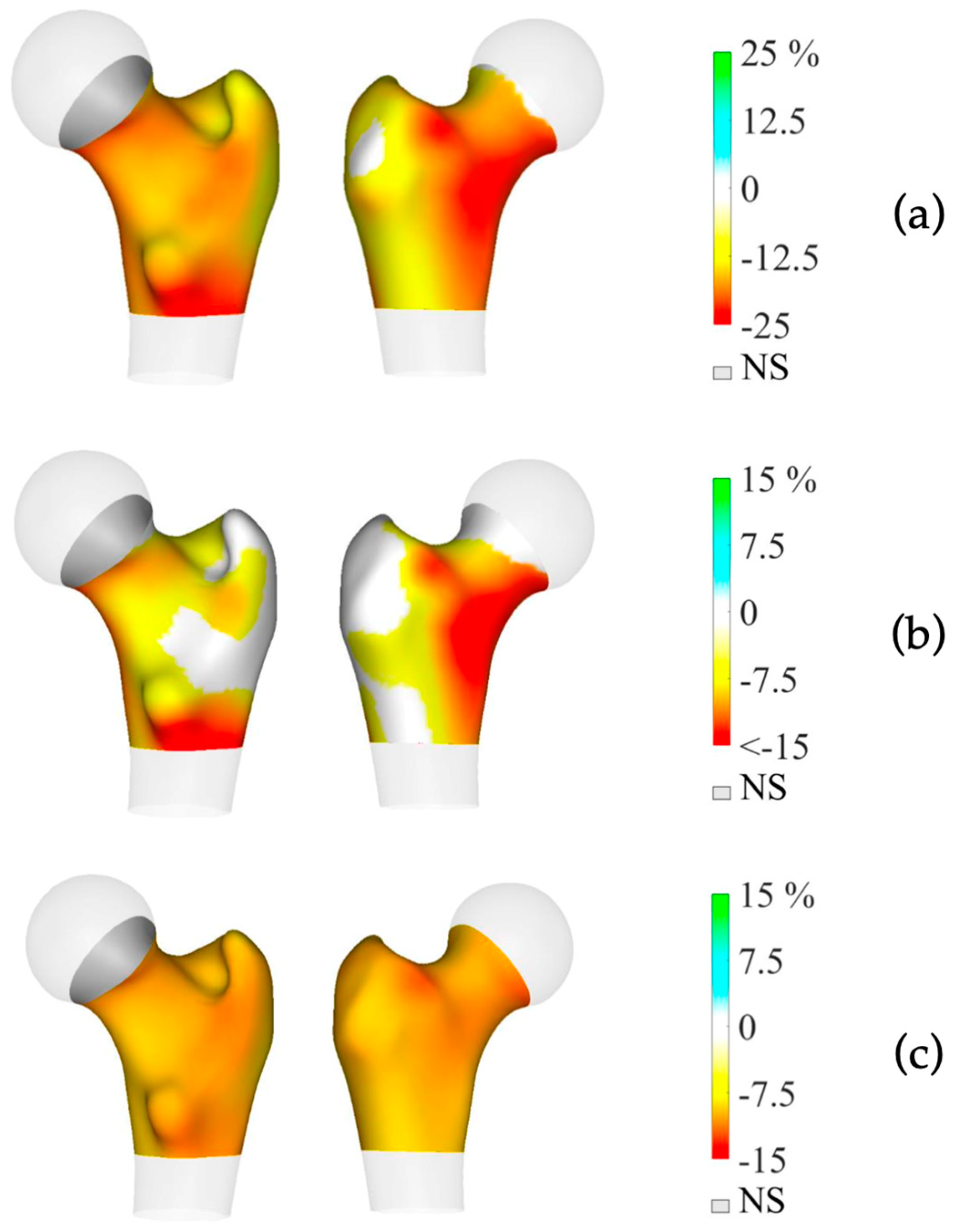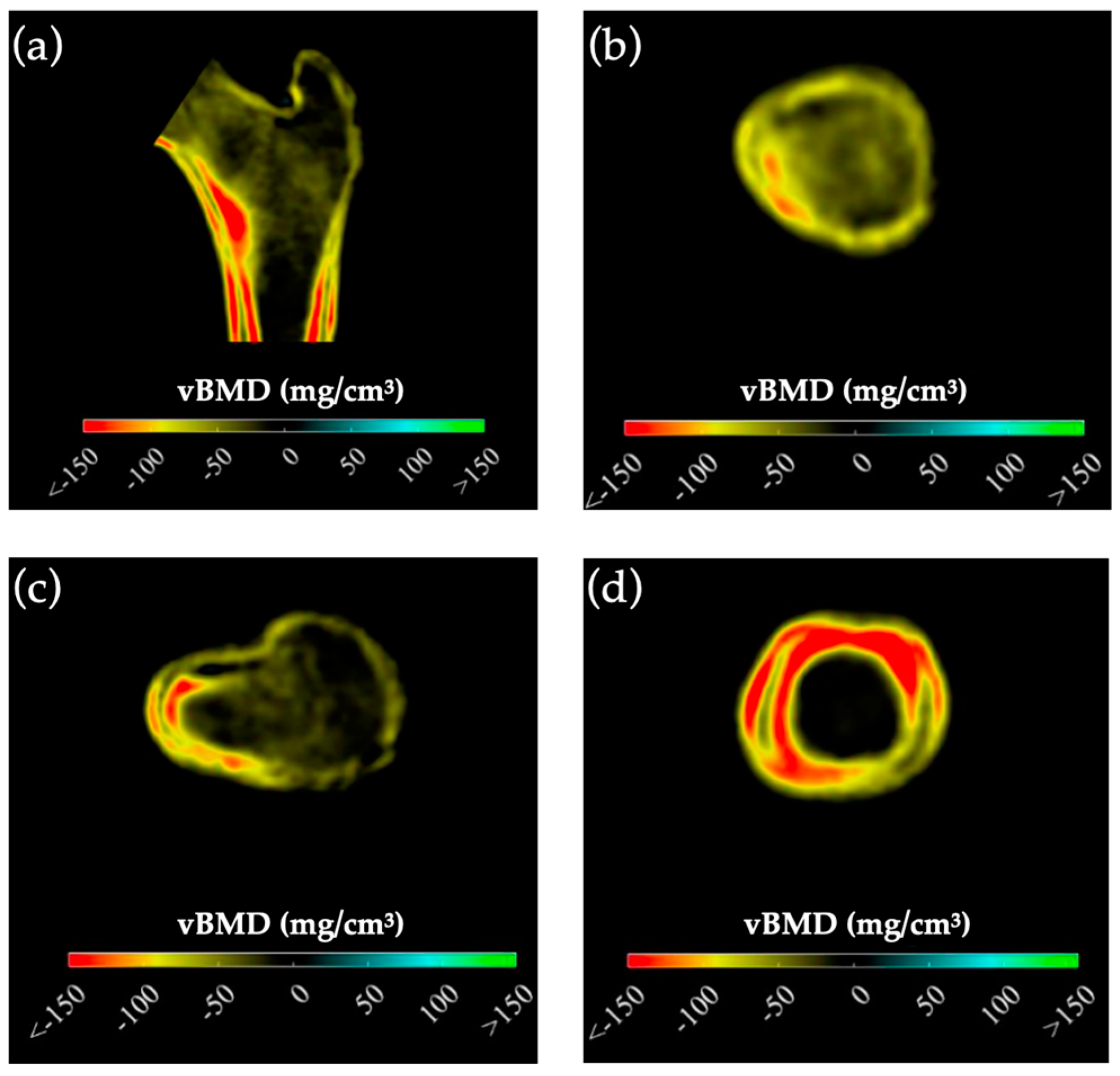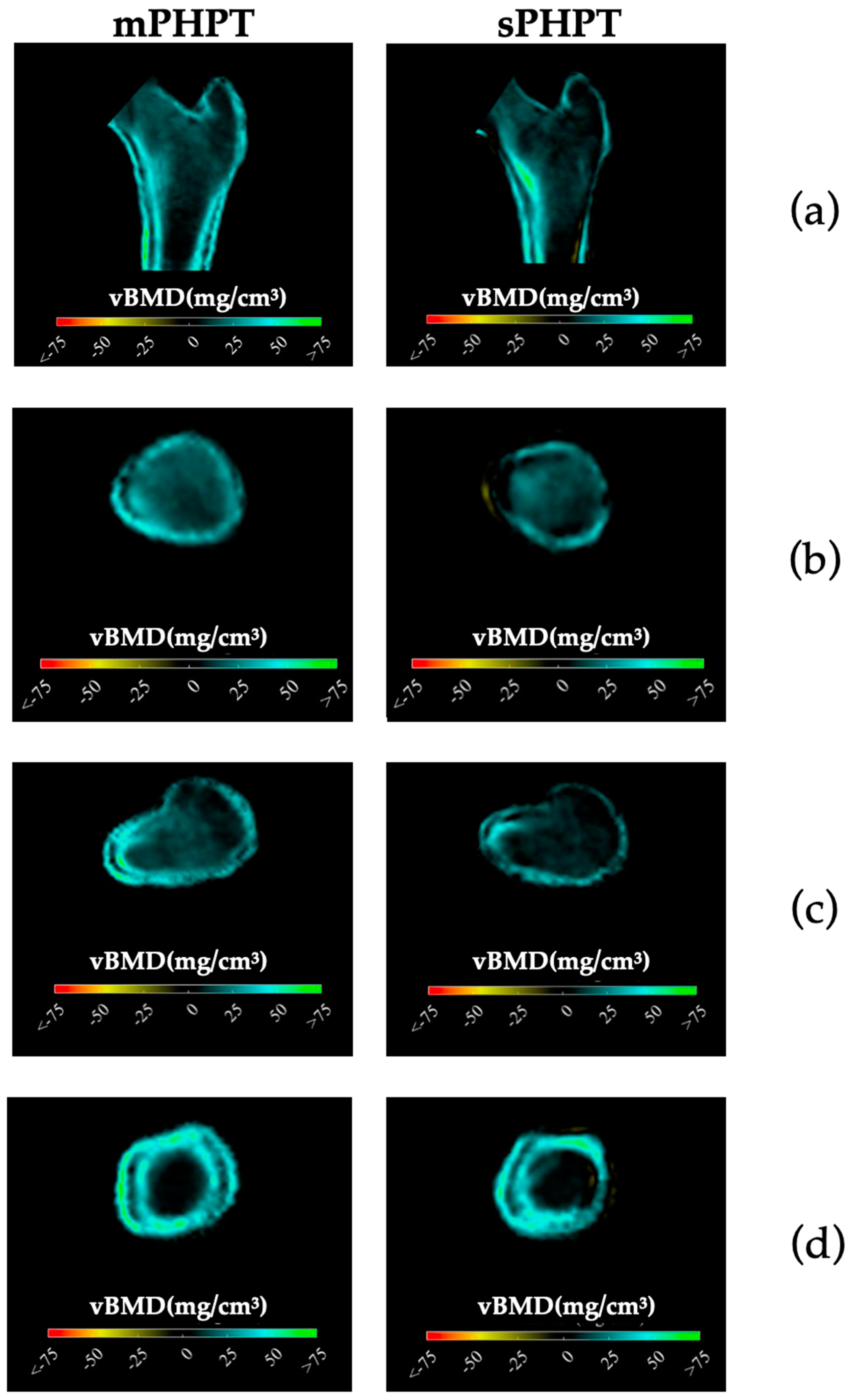Analysis of Bone Phenotype Differences in MEN1-Related and Sporadic Primary Hyperparathyroidism Using 3D-DXA
Abstract
1. Introduction
2. Materials and Methods
2.1. Study Design
2.2. Biochemical Evaluation
2.3. Instrumental Diagnosis
2.4. Screening for PHPT Complications
2.5. 3D-DXA
2.6. Genetic Analysis
2.7. Statistical Analysis
3. Results
3.1. Patients’ General Characteristics
3.2. Follow-Up of Primary Hyperparathyroidism
4. Discussion
5. Limitations and the Advantages of Research
6. Conclusions
Author Contributions
Funding
Institutional Review Board Statement
Informed Consent Statement
Data Availability Statement
Acknowledgments
Conflicts of Interest
References
- Brandi, M.L.; Agarwal, S.K.; Perrier, N.D.; Lines, K.E.; Valk, G.D.; Thakker, R.V. Multiple endocrine neoplasia type 1: Latest insights. Endocr. Rev. 2021, 42, 133–170. [Google Scholar] [CrossRef] [PubMed]
- Al-Salameh, A.; Cadiot, G.; Calender, A.; Goudet, P.; Chanson, P. Clinical aspects of multiple endocrine neoplasia type 1. Nat. Rev. Endocrinol. 2021, 17, 207–224. [Google Scholar] [CrossRef] [PubMed]
- Goudet, P.; Dalac, A.; Le Bras, M.; Cardot-Bauters, C.; Niccoli, P.; Levy-Bohbot, N.; du Boullay, H.; Bertagna, X.; Ruszniewski, P.; Borson-Chazot, F.; et al. Men1 disease occurring before 21 years old: A 160-patient cohort study from the groupe d’etude des tumeurs endocrines. J. Clin. Endocrinol. Metab. 2015, 100, 1568–1577. [Google Scholar] [CrossRef] [PubMed]
- Thakker, R.V.; Newey, P.J.; Walls, G.V.; Bilezikian, J.; Dralle, H.; Ebeling, P.R.; Melmed, S.; Sakurai, A.; Tonelli, F.; Brandi, M.L.; et al. Clinical practice guidelines for multiple endocrine neoplasia type 1 (men1). J. Clin. Endocrinol. Metab. 2012, 97, 2990–3011. [Google Scholar] [CrossRef]
- Twigt, B.A.; Scholten, A.; Valk, G.D.; Rinkes, I.H.; Vriens, M.R. Differences between sporadic and men related primary hyperparathyroidism; clinical expression, preoperative workup, operative strategy and follow-up. Orphanet J. Rare Dis. 2013, 8, 50. [Google Scholar] [CrossRef]
- Lourenco, D.M., Jr.; Coutinho, F.L.; Toledo, R.A.; Montenegro, F.L.; Correia-Deur, J.E.; Toledo, S.P. Early-onset, progressive, frequent, extensive, and severe bone mineral and renal complications in multiple endocrine neoplasia type 1-associated primary hyperparathyroidism. J. Bone Miner. Res. 2010, 25, 2382–2391. [Google Scholar] [CrossRef]
- Eller-Vainicher, C.; Chiodini, I.; Battista, C.; Viti, R.; Mascia, M.L.; Massironi, S.; Peracchi, M.; D’Agruma, L.; Minisola, S.; Corbetta, S.; et al. Sporadic and men1-related primary hyperparathyroidism: Differences in clinical expression and severity. J. Bone Miner. Res. 2009, 24, 1404–1410. [Google Scholar] [CrossRef]
- Mathew, U.E.; Goyal, A.; Upadhyay, A.D.; Kandasamy, D.; Agarwal, S.; Sharma, C.K.; Sharma, A.; Bal, C.; Tandon, N.; Jyotsna, V.P. Clinical profile and treatment outcomes among patients with sporadic and multiple endocrine neoplasia syndrome-related primary hyperparathyroidism. Clin. Endocrinol. 2023, 99, 449–458. [Google Scholar] [CrossRef]
- Silva, A.M.; Vodopivec, D.; Christakis, I.; Lyons, G.; Wei, Q.; Waguespack, S.G.; Petak, S.M.; Grubbs, E.; Lee, J.E.; Perrier, N. Operative intervention for primary hyperparathyroidism offers greater bone recovery in patients with sporadic disease than in those with multiple endocrine neoplasia type 1-related hyperparathyroidism. Surgery 2017, 161, 107–115. [Google Scholar] [CrossRef]
- Lourenco, D.M., Jr.; Toledo, R.A.; Mackowiak, I.I.; Coutinho, F.L.; Cavalcanti, M.G.; Correia-Deur, J.E.; Montenegro, F.; Siqueira, S.A.; Margarido, L.C.; Machado, M.C.; et al. Multiple endocrine neoplasia type 1 in brazil: Men1 founding mutation, clinical features, and bone mineral density profile. Eur. J. Endocrinol. 2008, 159, 259–274. [Google Scholar] [CrossRef]
- Kann, P.H.; Bartsch, D.; Langer, P.; Waldmann, J.; Hadji, P.; Pfutzner, A.; Klusener, J. Peripheral bone mineral density in correlation to disease-related predisposing conditions in patients with multiple endocrine neoplasia type 1. J. Endocrinol. Invest. 2012, 35, 573–579. [Google Scholar] [CrossRef] [PubMed]
- Altieri, B.; Di Dato, C.; Modica, R.; Bottiglieri, F.; Di Sarno, A.; Pittaway, J.F.H.; Martini, C.; Faggiano, A.; Colao, A. Bone metabolism and vitamin d implication in gastroenteropancreatic neuroendocrine tumors. Nutrients 2020, 12, 1021. [Google Scholar] [CrossRef] [PubMed]
- den Dunnen, J.T.; Dalgleish, R.; Maglott, D.R.; Hart, R.K.; Greenblatt, M.S.; McGowan-Jordan, J.; Roux, A.F.; Smith, T.; Antonarakis, S.E.; Taschner, P.E. Hgvs recommendations for the description of sequence variants: 2016 update. Hum. Mutat. 2016, 37, 564–569. [Google Scholar] [CrossRef] [PubMed]
- Xiong, H.Y.; Alipanahi, B.; Lee, L.J.; Bretschneider, H.; Merico, D.; Yuen, R.K.; Hua, Y.; Gueroussov, S.; Najafabadi, H.S.; Hughes, T.R.; et al. Rna splicing. The human splicing code reveals new insights into the genetic determinants of disease. Science 2015, 347, 1254806. [Google Scholar] [CrossRef] [PubMed]
- Agarwal, S.K.; Kester, M.B.; Debelenko, L.V.; Heppner, C.; Emmert-Buck, M.R.; Skarulis, M.C.; Doppman, J.L.; Kim, Y.S.; Lubensky, I.A.; Zhuang, Z.; et al. Germline mutations of the men1 gene in familial multiple endocrine neoplasia type 1 and related states. Hum. Mol. Genet. 1997, 6, 1169–1175. [Google Scholar] [CrossRef]
- Cho, Y.Y.; Chung, Y.J. A germline c.1546dupc men1 mutation in an men1 family: A case report. Medicine 2021, 100, e26382. [Google Scholar] [CrossRef]
- Pieterman, C.R.; van Hulsteijn, L.T.; den Heijer, M.; van der Luijt, R.B.; Bonenkamp, J.J.; Hermus, A.R.; Borel Rinkes, I.H.; Vriens, M.R.; Valk, G.D.; Dutch, M.E.N.S.G. Primary hyperparathyroidism in men1 patients: A cohort study with longterm follow-up on preferred surgical procedure and the relation with genotype. Ann. Surg. 2012, 255, 1171–1178. [Google Scholar] [CrossRef]
- Boguszewski, C.L.; Bianchet, L.C.; Raskin, S.; Nomura, L.M.; Borba, L.A.; Cavalcanti, T.C. Application of genetic testing to define the surgical approach in a sporadic case of multiple endocrine neoplasia type 1. Arq. Bras. Endocrinol. Metabol. 2010, 54, 705–710. [Google Scholar] [CrossRef]
- Canaff, L.; Vanbellinghen, J.F.; Kanazawa, I.; Kwak, H.; Garfield, N.; Vautour, L.; Hendy, G.N. Menin missense mutants encoded by the men1 gene that are targeted to the proteasome: Restoration of expression and activity by chip sirna. J. Clin. Endocrinol. Metab. 2012, 97, E282–E291. [Google Scholar] [CrossRef]
- Eremkina, A.K.; Sazonova, D.V.; Bibik, E.E.; Sheikhova, A.Z.; Khairieva, A.V.; Buklemishev, Y.V.; Mokrysheva, N.G. Severe bone complications of primary hyperparathyroidism in a young patient with the rare verified mutation of men1. Probl. Endokrinol. (Mosk) 2022, 68, 81–93. [Google Scholar] [CrossRef]
- Marini, F.; Giusti, F.; Fossi, C.; Cioppi, F.; Cianferotti, L.; Masi, L.; Boaretto, F.; Zovato, S.; Cetani, F.; Colao, A.; et al. Multiple endocrine neoplasia type 1: Analysis of germline men1 mutations in the italian multicenter men1 patient database. Endocrine 2018, 62, 215–233. [Google Scholar] [CrossRef] [PubMed]
- Mamedova, E.; Mokrysheva, N.; Vasilyev, E.; Petrov, V.; Pigarova, E.; Kuznetsov, S.; Kuznetsov, N.; Rozhinskaya, L.; Melnichenko, G.; Dedov, I.; et al. Primary hyperparathyroidism in young patients in russia: High frequency of hyperparathyroidism-jaw tumor syndrome. Endocr. Connect. 2017, 6, 557–565. [Google Scholar] [CrossRef]
- Hu, W.M.; Zhang, Q.; Huang, L.H.; Mo, Z.H.; Long, X.D.; Yang, Y.B.; Yang, W.J.; Liu, J.; Jin, P. Identification of novel variants in men1: A study conducted with four multiple endocrine neoplasia type 1 patients. Horm. Metab. Res. 2020, 52, 788–795. [Google Scholar] [CrossRef]
- Kihara, M.; Miyauchi, A.; Ito, Y.; Yoshida, H.; Miya, A.; Kobayashi, K.; Takamura, Y.; Fukushima, M.; Inoue, H.; Higashiyama, T.; et al. Men1 gene analysis in patients with primary hyperparathyroidism: 10-year experience of a single institution for thyroid and parathyroid care in japan. Endocr. J. 2009, 56, 649–656. [Google Scholar] [CrossRef]
- Padidela, R.; Fiest, M.; Arya, V.; Smith, V.V.; Ashworth, M.; Rampling, D.; Newbould, M.; Batra, G.; James, J.; Wright, N.B.; et al. Insulinoma in childhood: Clinical, radiological, molecular and histological aspects of nine patients. Eur. J. Endocrinol. 2014, 170, 741–747. [Google Scholar] [CrossRef]
- Bilezikian, J.P.; Cusano, N.E.; Khan, A.A.; Liu, J.M.; Marcocci, C.; Bandeira, F. Primary hyperparathyroidism. Nat. Rev. Dis. Primers 2016, 2, 16033. [Google Scholar] [CrossRef]
- Chen Cardenas, S.M.; El-Kaissi, S.; Jarad, O.; Liaqat, M.; Korbonits, M.; Hamrahian, A.H. Unusual combination of men-1 and the contiguous gene deletion syndrome of cah and ehlers-danlos syndrome (cah-x). J. Endocr. Soc. 2020, 4, bvaa077. [Google Scholar] [CrossRef]
- Cardoso, L.; Stevenson, M.; Thakker, R.V. Molecular genetics of syndromic and non-syndromic forms of parathyroid carcinoma. Hum. Mutat. 2017, 38, 1621–1648. [Google Scholar] [CrossRef]
- Ozveren, A.; Akinci, B.; Makay, O.; Sarsik, B.; Simsir, I.Y.; Berdeli, A.; Akyildiz, M. A puzzling case of phospho-soda-induced hypocalcemia in a patient with multiple endocrine neoplasia type 1-associated primary hyperparathyroidism. Intern. Med. 2012, 51, 3145–3149. [Google Scholar] [CrossRef][Green Version]
- Görtz, B.; Roth, J.; Speel, E.J.; Krähenmann, A.; De Krijger, R.R.; Matias-Guiu, X.; Muletta-Feurer, S.; Rütmann, K.; Saremaslani, P.; Heitz, P.U.; et al. Men1 gene mutation analysis of sporadic adrenocortical lesions. Int. J. Cancer 1999, 80, 373–379. [Google Scholar] [CrossRef]
- Klementieva, N.; Goliusova, D.; Krupinova, J.; Yanvarev, V.; Panova, A.; Mokrysheva, N.; Kiselev, S.L. A novel isogenic human cell-based system for men1 syndrome generated by crispr/cas9 genome editing. Int. J. Mol. Sci. 2021, 22, 12054. [Google Scholar] [CrossRef] [PubMed]
- Romanet, P.; Odou, M.F.; North, M.O.; Saveanu, A.; Coppin, L.; Pasmant, E.; Mohamed, A.; Goudet, P.; Borson-Chazot, F.; Calender, A.; et al. Proposition of adjustments to the acmg-amp framework for the interpretation of men1 missense variants. Hum. Mutat. 2019, 40, 661–674. [Google Scholar] [CrossRef] [PubMed]
- Luo, Y.; Sun, Y.; Zhu, X.; Li, X. Analysis of men1 c.482g>a (p.Gly161asp) mutation in a pedigree with familial multiple endocrine neoplasia type 1. Mol. Med. Rep. 2017, 16, 8973–8976. [Google Scholar] [CrossRef]
- Mutch, M.G.; Dilley, W.G.; Sanjurjo, F.; DeBenedetti, M.K.; Doherty, G.M.; Wells, S.A., Jr.; Goodfellow, P.J.; Lairmore, T.C. Germline mutations in the multiple endocrine neoplasia type 1 gene: Evidence for frequent splicing defects. Hum. Mutat. 1999, 13, 175–185. [Google Scholar] [CrossRef]
- Cardinal, J.W.; Bergman, L.; Hayward, N.; Sweet, A.; Warner, J.; Marks, L.; Learoyd, D.; Dwight, T.; Robinson, B.; Epstein, M.; et al. A report of a national mutation testing service for the men1 gene: Clinical presentations and implications for mutation testing. J. Med. Genet. 2005, 42, 69–74. [Google Scholar] [CrossRef]
- Poncin, J.; Abs, R.; Velkeniers, B.; Bonduelle, M.; Abramowicz, M.; Legros, J.J.; Verloes, A.; Meurisse, M.; Van Gaal, L.; Verellen, C.; et al. Mutation analysis of the men1 gene in belgian patients with multiple endocrine neoplasia type 1 and related diseases. Hum. Mutat. 1999, 13, 54–60. [Google Scholar] [CrossRef]
- Klein, R.D.; Salih, S.; Bessoni, J.; Bale, A.E. Clinical testing for multiple endocrine neoplasia type 1 in a DNA diagnostic laboratory. Genet. Med. 2005, 7, 131–138. [Google Scholar] [CrossRef]
- Maraghelli, D.; Giusti, F.; Marini, F.; Brandi, M.L. Bone tissue and mineral metabolism in hereditary endocrine tumors: Clinical manifestations and genetic bases. Orphanet J. Rare Dis. 2020, 15, 102. [Google Scholar] [CrossRef]
- Mokrysheva, N.G.; Eremkina, A.K.; Elfimova, A.R.; Kovaleva, E.V.; Miliutina, A.P.; Bibik, E.E.; Gorbacheva, A.M.; Dobreva, E.A.; Maganeva, I.S.; Krupinova, J.A.; et al. The russian registry of primary hyperparathyroidism, latest update. Front. Endocrinol. 2023, 14, 1203437. [Google Scholar] [CrossRef]
- Kong, J.; Wang, O.; Nie, M.; Shi, J.; Hu, Y.; Jiang, Y.; Li, M.; Xia, W.; Meng, X.; Xing, X. Clinical and genetic analysis of multiple endocrine neoplasia type 1-related primary hyperparathyroidism in chinese. PLoS ONE 2016, 11, e0166634. [Google Scholar] [CrossRef]
- Lourenco, D.M., Jr.; Coutinho, F.L.; Toledo, R.A.; Goncalves, T.D.; Montenegro, F.L.; Toledo, S.P. Biochemical, bone and renal patterns in hyperparathyroidism associated with multiple endocrine neoplasia type 1. Clinics 2012, 67 (Suppl. S1), 99–108. [Google Scholar] [CrossRef]
- Marini, F.; Giusti, F.; Cioppi, F.; Maraghelli, D.; Cavalli, T.; Tonelli, F.; Brandi, M.L. Bone and mineral metabolism phenotypes in men1-related and sporadic primary hyperparathyroidism, before and after parathyroidectomy. Cells 2021, 10, 1895. [Google Scholar] [CrossRef] [PubMed]
- Makras, P.; Anastasilakis, A.D. Bone disease in primary hyperparathyroidism. Metabolism 2018, 80, 57–65. [Google Scholar] [CrossRef]
- Vu, T.D.; Wang, X.F.; Wang, Q.; Cusano, N.E.; Irani, D.; Silva, B.C.; Ghasem-Zadeh, A.; Udesky, J.; Romano, M.E.; Zebaze, R.; et al. New insights into the effects of primary hyperparathyroidism on the cortical and trabecular compartments of bone. Bone 2013, 55, 57–63. [Google Scholar] [CrossRef]
- Wang, W.; Nie, M.; Jiang, Y.; Li, M.; Meng, X.; Xing, X.; Wang, O.; Xia, W. Impaired geometry, volumetric density, and microstructure of cortical and trabecular bone assessed by hr-pqct in both sporadic and men1-related primary hyperparathyroidism. Osteoporos. Int. 2020, 31, 165–173. [Google Scholar] [CrossRef]
- Song, A.; Chen, R.; Guan, W.; Yu, W.; Yang, Y.; Wang, J.; Nie, M.; Jiang, Y.; Li, M.; Xia, W.; et al. Trabecular bone score as a more sensitive tool to evaluate bone involvement in men1-related primary hyperparathyroidism. J. Clin. Endocrinol. Metab. 2023, 109, 135–142. [Google Scholar] [CrossRef]
- Burgess, J.R.; David, R.; Greenaway, T.M.; Parameswaran, V.; Shepherd, J.J. Osteoporosis in multiple endocrine neoplasia type 1: Severity, clinical significance, relationship to primary hyperparathyroidism, and response to parathyroidectomy. Arch. Surg. 1999, 134, 1119–1123. [Google Scholar] [CrossRef]
- Kenkre, J.S.; Bassett, J. The bone remodelling cycle. Ann. Clin. Biochem. 2018, 55, 308–327. [Google Scholar] [CrossRef]
- Coutinho, F.L.; Lourenco, D.M., Jr.; Toledo, R.A.; Montenegro, F.L.; Correia-Deur, J.E.; Toledo, S.P. Bone mineral density analysis in patients with primary hyperparathyroidism associated with multiple endocrine neoplasia type 1 after total parathyroidectomy. Clin. Endocrinol. 2010, 72, 462–468. [Google Scholar] [CrossRef]
- Gorbacheva, A.; Eremkina, A.; Goliusova, D.; Krupinova, J.; Mokrysheva, N. The role of menin in bone pathology. Endocr. Connect. 2022, 11, e210494. [Google Scholar] [CrossRef]





| mPHPT | sPHPT | mPHPT vs. sPHPT | mPHPT vs. sPHPT | |||
|---|---|---|---|---|---|---|
| Variables | N | Me [Q1; Q3] or n (%) | N | Me [Q1; Q3] or n (%) | p-Value | p0-Value |
| PTH, pg/mL | 22 | 131.60 [95.92; 198.30] | 37 | 117.30 [102.30; 169.50] | 0.931 1 | 0.048 |
| Albumin-corrected calcium (mmol/L) | 22 | 2.69 [2.62; 2.80] | 36 | 2.69 [2.63; 2.77] | 0.911 1 | 0.046 |
| Phosphorus (mmol/L) | 20 | 0.79 [0.71; 0.94] | 36 | 0.81 [0.73; 0.89] | 0.669 1 | 0.045 |
| eGFR mL/min/1.73 m2 | 22 | 110.30 [95.40; 116.70] | 36 | 102.50 [93.30; 110.60] | 0.194 1 | 0.030 |
| 24-h urine calcium (mmol/L) | 21 | 8.22 [6.42; 10.29] | 37 | 8.62 [6.60; 10.90] | 0.651 1 | 0.043 |
| Osteocalcin (ng/mL) | 18 | 55.88 [34.32; 70.06] | 29 | 48.66 [34.08; 61.16] | 0.592 1 | 0.038 |
| b-CrossLaps (ng/mL) | 17 | 1.00 [0.75; 1.26] | 28 | 0.881 [0.61; 1.28] | 0.665 1 | 0.044 |
| Nephrolithiasis | 22 | 12 (54.5%) | 37 | 23 (62.2%) | 0.594 2 | 0.039 |
| Low-energy fractures | 22 | 2 (9.1%) | 37 | 2 (5.4%) | 0.624 2 | 0.040 |
| Z-score less than −2.0 SD and/or low-energy fractures reported | 22 | 13 (59.1%) | 37 | 10 (27.0%) | 0.026 2 | 0.019 |
| N | Sex, Age | HGVS Nomenclature | Protein | SNP | Type of Variant * | Significance | Reference |
|---|---|---|---|---|---|---|---|
| 1 | Male, 20 | c.923C > A | p.Ser308Ter | rs1565644366 | Nonsense | P | [14,15] |
| 2 | Female, 39 | c.830_831insGTAC | p.Ala279TyrfsTer39 | - | Frameshift | LP | Not described |
| 3 | Female, 18 | c.1716_1718del | p.Ser573del | - | Frameshift | VUS | Not described |
| 4 | Female, 36 | c.87_96del | p.Glu30ThrfsTer86 | - | Frameshift | LP | Not described |
| 5 | Female, 29 | c.1546dup | p.Arg516ProfsTer15 | rs767319284 | Frameshift | P | [15,16,17,18] |
| 6 | Male, 36 | c.1340T > C | p.Phe447Ser | rs1941604532 | Missense | P | [15,19] |
| 7 | Female, 34 | c.87_96del | p.Glu30ThrfsTer86 | - | Frameshift | P | Not described |
| 8 | Female, 37 | c.398_436del | p.Tyr133_Ser145del | - | Frameshift | LP | Not described |
| 9 | Male, 22 | c.1594G > T | p.Gly537Cys | rs587780843 | Missense | VUS | [20] |
| 10 | Female, 41 | c.658T > C | p.Trp220Arg | rs1085307971 | Missense | LP | [21,22] |
| 11 | Female, 37 | c.249_252del | p.Ile85Serfs *33 | rs587776841 | Frameshift | P | [23,24] |
| 12 | Female, 39 | c.1252_1254delinsTAT | p.Asp418Tyr | - | Delins | P | Not described |
| 13 | Female, 32 | c.784-9G > A | - | rs794728625 | Splicing | P | [25,26,27,28,29,30] |
| 14 | Female, 36 | c.1252G > T | p.Asp418Tyr | rs104894264 | Missense | P | [31] |
| 15 | Female, 35 | c.1546dup | p.Arg516Profs * 15 | rs767319284 | Frameshift | P | [15,16,17,18] |
| 16 | Female, 40 | c.-23-14G > A | - | rs886048479 | Splicing | VUS | Not described |
| 17 | Female, 28 | c.681C > T | p.Tyr227 | rs778921501 | Synonymous | LB | Not described |
| 18 | Female,40 | c.658T > C | p.Trp220Arg | rs1085307971 | Missense | LP | [21,22] |
| 19 | Female, 44 | c.467G > A | p.Gly156Asp | rs794728648 | Missense | P | [32,33,34] |
| 20 | Female, 25 | c.658T>C | p.Trp220Arg | rs1085307971 | Missense | LP | [21,22] |
| 21 | Female, 39 | c.772C > T | p.Gln258Ter | rs886039416 | Nonsense | P | [14,35,36] |
| 22 | Male, 24 | c.1602_1618dup | p.Pro540ArgfsTer25 | rs794728660 | Frameshift | P | [37] |
| mPHPT | sPHPT | mPHPT vs. sPHPT | mPHPT vs. sPHPT | |||
|---|---|---|---|---|---|---|
| Variables | N | Me [Q1; Q3] | N | Me [Q1; Q3] | p-value | p0-value |
| BMD LS g/cm2 | 21 | 1.02 [0.93; 1.11] | 37 | 1.15 [1.07; 1.22] | 0.002 | 0.006 |
| LS Z-score | 21 | −1.50 [−1.90; −1.00] | 37 | −0.50 [−1.20; −0.10] | 0.012 | 0.016 |
| BMD FN g/cm2 | 22 | 0.81 [0.67; 0.94] | 37 | 0.94 [0.88; 1.04] | 0.001 | 0.004 |
| FN Z-score | 22 | −1.60 [−1.90; −0.80] | 37 | −0.40 [−1.0; 0.00] | 0.004 | 0.011 |
| BMD TH g/cm2 | 22 | 0.89 [0.72; 0.92] | 37 | 0.97 [0.89; 1.10] | 0.002 | 0.008 |
| TH Z-score | 22 | −1.00 [−1.80; −0.40] | 36 | −0.40 [−0.90; 0.40] | 0.018 | 0.018 |
| BMD RT g/cm2 | 22 | 0.58 [0.53; 0.66] | 35 | 0.64 [0.58; 0.72] | 0.059 | 0.023 |
| RT Z-score | 22 | −1.50 [−2.60; −0.30] | 36 | −0.60 [−1.60; 0.30] | 0.062 | 0.024 |
| BMD R33% g/cm2 | 22 | 0.74 [0.68; 0.85] | 35 | 0.82 [0.78; 0.89] | 0.036 | 0.021 |
| R33% Z-score | 21 | −1.50 [−2.3; −0.9] | 15 | −0.60 [−1.10; 0.00] | 0.007 | 0.013 |
| TBS (RI > 1310) | 9 | 1.39 [1.32; 1.45] | 37 | 1.49 [1.40; 1.51] | 0.136 | 0.029 |
| Cortical sBMD TH (mg/cm2) | 22 | 131.15 [106.96; 150.63] | 37 | 151.95 [141.89; 163.72] | 0.001 | 0.005 |
| Cortical sBMD FN (mg/cm2) | 22 | 102.06 [92.54; 118.58] | 37 | 130.10 [119.68; 138.09] | <0.001 | 0.001 |
| Trabecular vBMD TH (mg/cm3) | 22 | 142.22 [105.29; 181.17] | 37 | 168.81 [150.22; 212.23] | 0.029 | 0.020 |
| Trabecular vBMD FN (mg/cm3) | 22 | 181.93 [154.69; 235.27] | 37 | 237.74 [212.92; 265.67] | 0.008 | 0.015 |
| Cortical vBMD TH (mg/cm3) | 22 | 724.79 [652.67; 779.78] | 37 | 800.74 [751.19; 857.710] | 0.007 | 0.014 |
| Cortical vBMD FN (mg/cm3) | 22 | 713.81 [671.471; 768.502] | 37 | 797.82 [758.03; 858.38] | 0.002 | 0.009 |
| Cortical Thickness TH (mm) | 22 | 1.77 [1.65; 1.83] | 37 | 1.910 [1.86; 2.01] | <0.001 | 0.003 |
| Cortical Thickness FN (mm) | 22 | 1.48 [1.40; 1.59] | 37 | 1.65 [1.49; 1.80] | 0.002 | 0.010 |
| mPHPT (Before Surgery) | mPHPT (After Surgery) | mPHPT Before and After Surgery | mPHPT Before and After Surgery | |||
|---|---|---|---|---|---|---|
| Variables | N | Me [Q1; Q3] | N | Me [Q1; Q3] | p-Value | p0-Value |
| Cortical sBMD TH (mg/cm2) | 11 | 135.70 [100.65; 153.83] | 11 | 147.71 [106.21; 168.08] | 0.001 | 0.004 |
| Cortical sBMD FN (mg/cm2) | 11 | 112.20 [95.04; 123.62] | 11 | 121.33 [101.16; 132.55] | 0.001 | 0.008 |
| Trabecular vBMD TH (mg/cm3) | 11 | 157.17 [113.95; 177.26] | 11 | 172.62 [120.75; 226.64] | 0.019 | 0.035 |
| Trabecular vBMD FN (mg/cm3) | 11 | 204.18 [170.26; 226.75] | 11 | 207.64 [170.02; 286.12] | 0.019 | 0.038 |
| Cortical vBMD TH (mg/cm3) | 11 | 745.44 [597.69; 776.26] | 11 | 761.41 [614.26; 835.44] | 0.005 | 0.012 |
| Cortical vBMD FN (mg/cm3) | 11 | 738.11 [636.25; 781.54] | 11 | 767.69 [667.84; 816.35] | 0.019 | 0.042 |
| Cortical Thickness TH (mm) | 11 | 1.79 [1.68; 1.96] | 11 | 1.878 [1.73; 2.01] | 0.005 | 0.015 |
| Cortical Thickness FN (mm) | 11 | 1.61 [1.50; 1.71] | 11 | 1.65 [1.58; 1.71] | 0.007 | 0.023 |
| sPHPT (Before Surgery) | sPHPT (After Surgery) | sPHPT Before and After Surgery | sPHPT Before and After Surgery | |||
|---|---|---|---|---|---|---|
| Variables | N | Me [Q1; Q3] | N | Me [Q1; Q3] | p-value | p0-value |
| Cortical sBMD TH (mg/cm2) | 14 | 157.06 [140.41; 178.59] | 14 | 174.11 [147.50; 186.59] | 0.005 | 0.012 |
| Cortical sBMD FN (mg/cm2) | 14 | 133.07 [123.91; 149.90] | 14 | 142.11 [131.30; 150.76] | 0.058 | 0.035 |
| Trabecular vBMD TH (mg/cm3) | 14 | 166.93 [144.94; 232.28] | 14 | 203.19 [151.75; 229.46] | 0.035 | 0.031 |
| Trabecular vBMD FN (mg/cm3) | 14 | 232.96 [213.04; 287.85] | 14 | 251.00 [224.43; 278.63] | 0.020 | 0.027 |
| Cortical vBMD TH (mg/cm3) | 14 | 816.77 [766.93; 935.14] | 14 | 843.29 [835.00; 925.19] | 0.013 | 0.023 |
| Cortical vBMD FN (mg/cm3) | 14 | 826.03 [788.36; 910.54] | 14 | 845.87 [819.88; 905.26] | 0.011 | 0.019 |
| Cortical Thickness TH (mm) | 14 | 1.93 [1.85; 2.11] | 14 | 1.98 [1.87; 2.10] | 0.502 | 0.042 |
| Cortical Thickness FN (mm) | 14 | 1.70 [1.57; 1.84] | 14 | 1.67 [1.55; 1.84] | 0.855 | 0.050 |
Disclaimer/Publisher’s Note: The statements, opinions and data contained in all publications are solely those of the individual author(s) and contributor(s) and not of MDPI and/or the editor(s). MDPI and/or the editor(s) disclaim responsibility for any injury to people or property resulting from any ideas, methods, instructions or products referred to in the content. |
© 2024 by the authors. Licensee MDPI, Basel, Switzerland. This article is an open access article distributed under the terms and conditions of the Creative Commons Attribution (CC BY) license (https://creativecommons.org/licenses/by/4.0/).
Share and Cite
Eremkina, A.K.; Pylina, S.V.; Elfimova, A.R.; Gorbacheva, A.M.; Humbert, L.; López Picazo, M.; Hajrieva, A.V.; Solodovnikova, E.N.; Kovalevich, L.D.; Vetchinkina, E.A.; et al. Analysis of Bone Phenotype Differences in MEN1-Related and Sporadic Primary Hyperparathyroidism Using 3D-DXA. J. Clin. Med. 2024, 13, 6382. https://doi.org/10.3390/jcm13216382
Eremkina AK, Pylina SV, Elfimova AR, Gorbacheva AM, Humbert L, López Picazo M, Hajrieva AV, Solodovnikova EN, Kovalevich LD, Vetchinkina EA, et al. Analysis of Bone Phenotype Differences in MEN1-Related and Sporadic Primary Hyperparathyroidism Using 3D-DXA. Journal of Clinical Medicine. 2024; 13(21):6382. https://doi.org/10.3390/jcm13216382
Chicago/Turabian StyleEremkina, Anna K., Svetlana V. Pylina, Alina R. Elfimova, Anna M. Gorbacheva, Ludovic Humbert, Mirella López Picazo, Angelina V. Hajrieva, Ekaterina N. Solodovnikova, Liliya D. Kovalevich, Ekaterina A. Vetchinkina, and et al. 2024. "Analysis of Bone Phenotype Differences in MEN1-Related and Sporadic Primary Hyperparathyroidism Using 3D-DXA" Journal of Clinical Medicine 13, no. 21: 6382. https://doi.org/10.3390/jcm13216382
APA StyleEremkina, A. K., Pylina, S. V., Elfimova, A. R., Gorbacheva, A. M., Humbert, L., López Picazo, M., Hajrieva, A. V., Solodovnikova, E. N., Kovalevich, L. D., Vetchinkina, E. A., Bondarenko, E. V., Tarbaeva, N. V., & Mokrysheva, N. G. (2024). Analysis of Bone Phenotype Differences in MEN1-Related and Sporadic Primary Hyperparathyroidism Using 3D-DXA. Journal of Clinical Medicine, 13(21), 6382. https://doi.org/10.3390/jcm13216382






